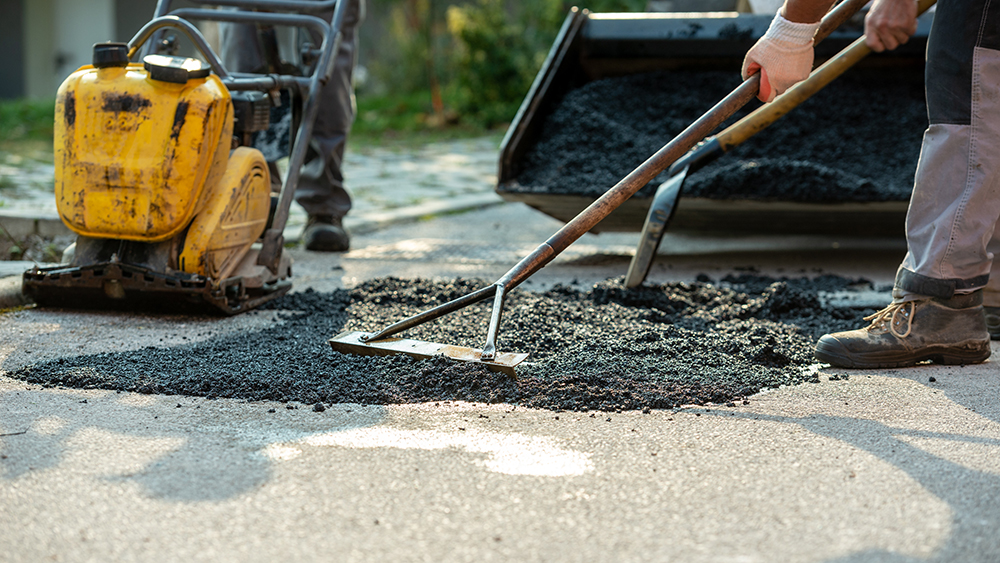Below are some asphalt repair tips for roads that are frequently used by heavy machinery.

When people think of asphalt repair, they automatically picture a road with a lot of traffic. It’s a relatively new form of paving construction and involves pouring a mixture of sand and concrete onto the surface of the road. Then, gravel and other materials are spread over the top layer of this mixture. This creates a smooth, flat, level road that’s easy to drive on and will resist many types of wear and tear that road users could inflict upon it.
A lot of the job of laying asphalt pavement is taken care of by equipment that can work without any human supervision. One example is an asphalt mixer that uses the mixture of sand and concrete as its basic ingredients. It’s basically a bucket that’s filled with sand and concrete. It works with a system of mixing and stirring, which ensures that the mixture is thoroughly mixed and ready to pour. The mixing process itself consists of a series of processes, which includes loading the bucket with the mixture, then spreading it out in a layer above the surface of the road.
Listed below are some asphalt repair tips for roads frequently used by heavy machinery.
Tip #1
The first tip for asphalt repair is to make sure that there are no underground problems. When there are underlying problems, the damage that occurs can extend to the roads. The asphalt may crack, and the road will become uneven. It may also have trouble absorbing the weight of heavy equipment, such as tractors. This is why it’s important to work on the roads before the contractor begins work.
It’s important for contractors, such as Black Diamond Seal Coating, to make sure that the roads are clear and that they don’t have any hazards. If this isn’t possible, then it’s important for the roads to be cleared as soon as possible. It’s important to make sure that the contractor uses proper equipment on the roads so that there’s no risk of damaging the roads when making repairs. This is necessary because if heavy equipment damages a road, it may need to be closed for long periods of time.
Tip #2
The second tip for repairing concrete is ensuring that you have it properly sealed. You can get this done by getting a sealant for concrete and, then, using this as a backing for the concrete. This is especially important if you have asphalt that’s prone to cracking and breaking. After applying the sealant, you should make sure that you have the concrete laid on its side because it will prevent any cracking from occurring.
Tip #3
The third tip for asphalt repair is to make sure that there are no other areas of concern on the road. Sometimes, a road may need to be fixed because of an accident or some other reason. You can choose to repair the road, but you’ll need to make sure that you don’t end up causing further damage to other areas of the road. There may be a need to repair the road because of a broken concrete or other conditions. Before any work is done on the road, it will be helpful for you to check to make sure that the road is safe to travel on.
Tip #4
One of the most important aspects to remember is that asphalt pavement isn’t made the same way that concrete is. When dealing with a broken asphalt surface, you need to use a non-abrasive detergent and a soft brush. This means that you should avoid scrubbing the surface because you may actually scratch or scar the asphalt itself. If you accidentally scrape or scar the asphalt, you can easily re-coat the area with a protective coating.
It’s a good idea to let the asphalt sit for a couple days before you start to remove the damaged section. This allows the asphalt to air dry before you begin to apply your new coating. This will also allow for the area to air out properly, which will speed up the repair process.
Before applying the new paint, you should carefully take off all of the old asphalt. It’s important that you don’t disturb any of the existing layers and that you don’t try to fill in the cracks.
Tip #5
Before the asphalt pavement is laid, it’s important to determine the best quality for the job. If you have to choose between different grades, there are a number of factors that should be considered, including the weather in your area, the traffic volume and average traffic speeds, and the condition of the surface. The type of material that will be used is also an important consideration since asphalt is also used in buildings, bridges, and even roads and parking lots.
Tip #6
Another tip for asphalt repair is to ensure that you don’t leave any streaks or spots on the surface. Since asphalt is porous, the slightest water stain will eventually get into it and cause it to expand, causing more problems. This makes it even more important to keep it clean and dry when you have it since excess moisture can actually lead to rotting.
Tip #7
There are several ways that homeowners can use to make their asphalt repairs last longer than a day or two. One way that most homeowners choose to add extra protection is to paint their newly paved roadways. This will prevent any type of chemical fumes from seeping into the roadway and causing damage to the road’s surface. Another great idea is to apply a protective coating to the concrete that’s used on the road.
Work With Professionals
You can save money by doing the repairs yourself, but it’s important to remember that DIY solutions don’t always warrant the best results when repairing roads using asphalt. In many cases, a local contractor will have the experience and knowledge to get the job done correctly, without causing too many adverse effects. To ensure top-quality output, it should be in your best interest to find and hire one.

William Duff
William Duff is a full-time blogger who produces high-quality articles on business and investment. Aside from regularly updating his blog with informative articles, William also sends articles to other websites.
Scott Ellyson, CEO of East West Manufacturing, brings decades of global manufacturing and supply chain leadership to the conversation. In this episode, he shares practical insights on scaling operations, navigating complexity, and building resilient manufacturing networks in an increasingly connected world.